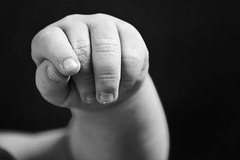 What hand does your child write with? Researchers have started to recognize the connections between brain development, left-handedness, and learning disabilities. It appears that the risk of developing learning disabilities, or mood disorders, has something to do with the way a person’s brain is wired.
What hand does your child write with? Researchers have started to recognize the connections between brain development, left-handedness, and learning disabilities. It appears that the risk of developing learning disabilities, or mood disorders, has something to do with the way a person’s brain is wired.
It has been estimated that around 10% of people are left-handed, and another 1% of the population is mixed-handed, (meaning that this group of people do not have a dominant hand). This means that the majority of people are right-handed. Most people write, eat, and do other daily tasks with their right hand. This is probably why the mouse attached to your computer is on the right hand side of your desk.
What causes left-handedness? Some of it is due to genetics. Researchers have found that some of what makes a person left-handed has to do with environmental factors. Mothers who experienced a high level of stress during their pregnancy are more likely give birth to a child who is left-hand dominant. Babies who are born to older mothers, or who were born with a lower birth rate, are more likely to be left-handed.
It is important for parents to understand that there is not a significant difference between the IQ of people who are left-handed and the IQ of people who are right-handed. There also isn’t anything that proves that left-handed people are more accident prone than their right-handed peers.
However, researchers have found that being left-handed seems to be associated with a higher risk for several psychiatric and developmental disorders. Around 20% of the people who have schizophrenia are left-handed. It also appears that “lefties” have a higher risk of being dyslexic, having ADHD, or having a mood disorder. People who are mixed-handed also are at a higher risk for having those types of special needs.
The reasons have to do with brain symmetry, and which side of the brain is dominant. The full explanation of how that works is complex. If I am understanding it correctly, it has something to do with the development of brain pathways, and with brain wiring, while a child is still in the womb. There is still more to be learned about how being left-handed, and having a learning disability, connects.
Parents and educators might want to take a closer look at children who are left-handed, (or who are mixed-handed). There is the potential that these children are more likely to have ADHD, dyslexia, and other learning disabilities than are their right-handed peers. The earlier that a learning disability, mood disorder, or other types of special needs are identified, the sooner treatment can begin. Much has been said about the benefits of starting treatment as early as possible.
Image by makelessnoise on Flickr

